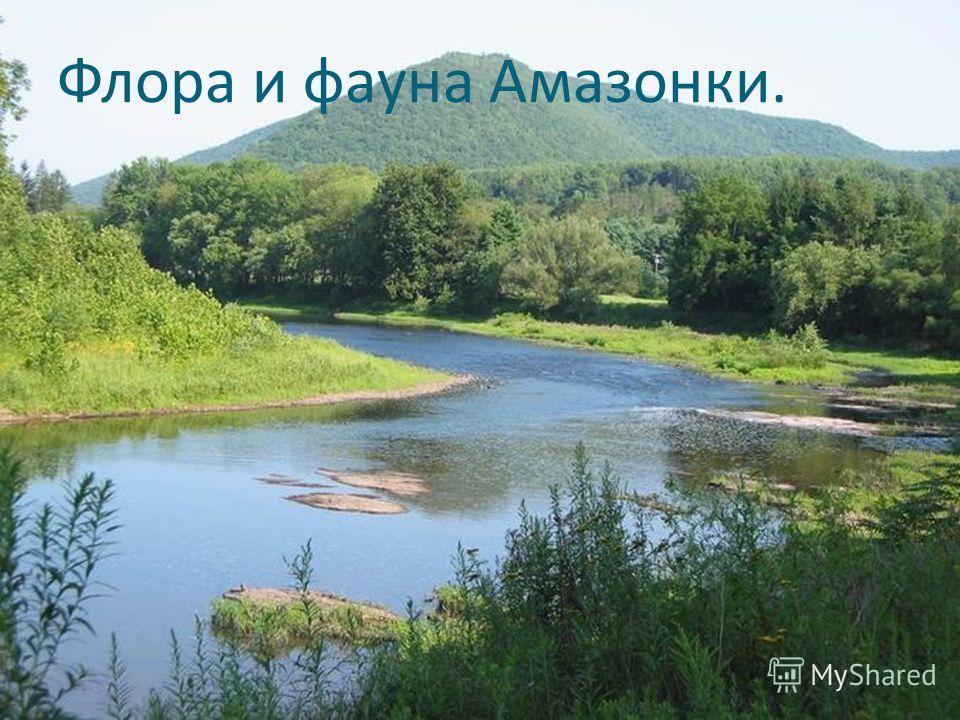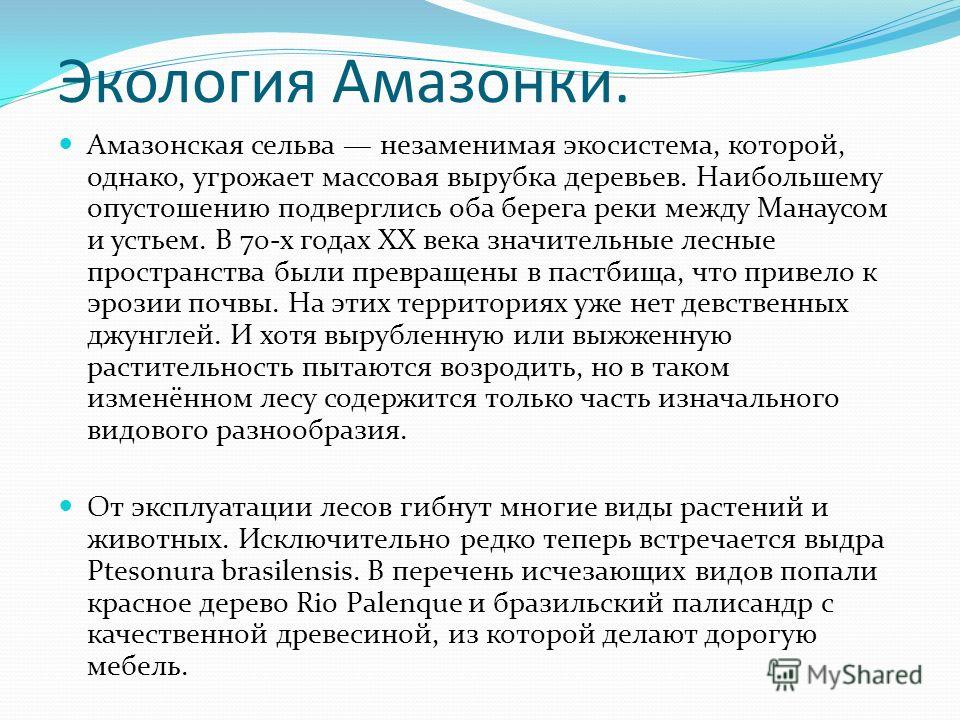The Amazon is the deepest, longest and most powerful river in the world. This is truly a priceless gift of nature. There is no place like this anywhere else on Earth. Everything amazing here is familiar. Reaching more than 6.5 thousand km deep into South America, the Amazon feeds with its waters the largest rain forest in the world, which is called “ lungs of the planet" This is the richest river on Earth. Up to several hundred meters deep and up to 40 km wide.
Man has not yet managed to conquer the Amazon: from its source to its very mouth, not a single bridge crosses it, not a single dam slows down its flow. For many centuries, the Amazon was protected from humans by the strength of its waters and the inaccessibility of the places in which it flows. Until recently, it was believed that nothing threatened these virgin forests. But aggressive industrial development is destroying the jungle, and the protection it provided to the river is disappearing. Today, the region's delicate ecological balance is on the brink of no return. The Amazon River crosses all of South America. Its basin - the largest in the world - is entangled with a thousand tributaries that flow into the main artery - the Amazon. The river's source is high in the Peruvian mountains, but the history of the Amazon begins at the intersection of two rivers - the Ucayali and Maranhão. Only after this confluence is the river in the jungle called the Amazon. The 240-kilometer river delta is an amazing sight. The river flows into Atlantic Ocean with such force that it repels salty sea water from its delta, which is the largest inland delta in the world (more than 100 thousand sq. km).
During the rainy season, the volume of water in the river increases sharply - the water level rises to 20 m, and the area occupied by the river triples! It is these extreme fluctuations in water levels that make the very idea of conquering the Amazon impossible. In addition, the river changes the configuration of its course so often that entire villages of coastal peoples can find themselves in the center of a new channel. This is due to the huge amount of water in the river, which easily transforms plains and areas with soft soil into a new channel. Such changes in the river bed make the soil fertile thanks to the river silt that the river brings from the Andes. Silt settles on the ground during river floods. Flood fields allow to the local population maintain continuous agriculture. The main channel of the Amazon flows almost exactly along the equator, where the earth receives maximum energy from the sun. In these conditions Live nature thrives, creating many forms adapted to such conditions. An excellent example is the flooded forests, which occupy an area of up to 20 km inland on both sides of the river. Trees grow long roots to survive, and some, like Rhizophora, even send out new roots from their branches to get nutrients from the water.  The Amazon basin is so huge that it has not yet been fully explored (there are many years of discussion on many forums on our planet); scientists have yet to discover thousands of plants and animals. The base of one of the research centers is located in the Piranha Nature Reserve in the middle of the river. This reserve is home to a huge number of fish species that are perfectly adapted to life in the flooded jungle. In such forests, the relationship between fish and trees is symbiotic: the fish feed on the fruits of the trees and then distribute them, as birds usually do. Working closely with local communities, research centers More than 50 new species are discovered per year!
The Amazon basin is so huge that it has not yet been fully explored (there are many years of discussion on many forums on our planet); scientists have yet to discover thousands of plants and animals. The base of one of the research centers is located in the Piranha Nature Reserve in the middle of the river. This reserve is home to a huge number of fish species that are perfectly adapted to life in the flooded jungle. In such forests, the relationship between fish and trees is symbiotic: the fish feed on the fruits of the trees and then distribute them, as birds usually do. Working closely with local communities, research centers More than 50 new species are discovered per year!
A magnificent sight is the place where the Rio Negro River with its blue waters flows into the muddy Amazon. 11 km brown and blue waters flow side by side before mixing to form largest river peace. At this point, the river represents an important trade route, allowing goods from the heart of the jungle to reach the open sea. Today, the Amazon is being polluted at the same rate as it is being cleaned, leading to a global environmental disaster. For the river itself, the crisis is very close, since it receives most of its water from precipitation. Without rain, the Amazon will cease to exist as we know it. And the further the river flows east, the greater the threat. The government is fighting illegal logging, but protecting an area larger than India is almost impossible. With deforestation, entire ecosystems are lost, half of which have not yet been studied, but this research could be very valuable for humanity. For example, scientists already know that more than a quarter of the active substances used in the manufacture of anti-cancer drugs come from tropical forests.
The Amazon rainforest, or Amazonian jungle, is located on a vast, almost flat plain that covers almost the entire river basin. The forest itself occupies 5.5 million square meters. km. It is located on the territory of nine countries (Brazil, Peru, Colombia, Venezuela, Ecuador, Bolivia, Guyana, Suriname, French Guiana). The Amazon forest is the largest a tropical forest Noah array in the world. These “lungs of the planet” occupy half of the total area of the planet’s remaining tropical forests. The southern tropical rainforests have the greatest biodiversity. The diversity of animals and plants here is much greater than in the tropical forests of Africa and Asia. Every tenth described animal or plant species is found in the Amazon jungle. At least 40 thousand species of plants, more than 3 thousand species of fish, 1300 species of birds, about 500 species of mammals, more than 400 species of amphibians, almost 400 species of reptiles and about 100 thousand species of various invertebrates have been described here. 
Due to ongoing climate change due to tree cutting (wood is considered the first source of raw materials), huge tracts of the Amazon rainforest may turn into the cerrado - the predominant type of arid savanna in modern Brazil. Based on satellite observations (NASO) of the floodplain of the Amazon River (Amazonia), scientists have noted a 70/80% reduction in forests over the past few decades. Deforestation has negatively affected the fragile ecological balance of the Amazon forests and led to the disappearance of many species of trees, shrubs, and ferns (plants and animals listed in the Red Book). In addition, the decomposition of wood residues and other vegetation as a result of logging and burning of forests leads to an increase in carbon dioxide emissions into the atmosphere by a quarter. This, in turn, increases the greenhouse effect of our planet.
Thus, ecologists (people who look after the planet:) and economists from Brazil, Spain and the USA note that the situation with deforestation has improved in recent years (since everyone is switching to plastic:), but it is too early to rejoice. Deforestation of the Amazon forests has only decreased, but not disappeared, and therefore Current state The Amazon is analyzed and further options for the development of events are considered. Well, what can I say, the Amazon and its forests are enough for our age... :)
Amazon. Amazon (port. Amazonas) river in South America, the largest in the world in terms of basin size, depth and length river system. Formed by the confluence of the Marañon and Ucayali rivers. The Amazon is fed by numerous tributaries; about 20 of them are more than 1500 km long.
Most of the Amazon basin belongs to Brazil, the southwestern and western regions of Bolivia, Peru, Ecuador and Colombia. Leaking for the most part along the Amazon Lowland in the sublatitudinal direction near the equator, the Amazon flows into the Atlantic Ocean, forming the world's largest delta (with an area of over 100 thousand km² and including the world's largest river island, Marajo).

The area of the river basin is almost equal to the area of Australia. The rise of water in the northern and southern tributaries of the Amazon occurs in different time of the year. This somewhat smoothes out fluctuations in the level of the Amazon, so it is full of water all year round. When the water rises, the river floods vast areas, forming impassable swamps.
![]()

The Amazon surprises with its richness of fauna and flora. Over a vast space inhabited by more than a million of the most different types plants and animals. Scientists say that per 10 km² of tropical forest there are 1.5 thousand species of flowers, 750 species of trees, 125 species of mammals, 400 species of birds and countless insects and invertebrates. Many of their species are not even described or identified.

The Amazon basin is also home to the world's largest tropical rainforest. This exceptional plant natural formation was described by Alexander von Humboldt during his travels to South America in the years, calling it hylea (from the Greek "hyleston" forest). The climate is evergreen equatorial forest hot and humid; all year round the temperature fluctuates within °C, and even at night does not fall below 20 °C. Rainfall here is unusually abundant: it annual amount is mm, but sometimes more falls out. There is no wind inside the forest, only during a storm the treetops sway. Little light penetrates through the thick leaves and intertwining vines under the tree crowns, and lush vegetation makes movement difficult, completely depriving one of orientation. To move even a short distance, you often need to cut a road

What is most characteristic of these places is the abundance of vines of thin, fast-growing stems, the length of which reaches 100 m. These plants twine around the trunks and branches of trees, reaching the crowns, where they find the light necessary for life; there they branch, bloom and bear fruit. Various devices (mustaches, thorns, thorns) help them climb and stay on trees. A real miracle flora is Victoria regia, a huge water lily so strong it can support the weight of a person.

Near rivers you can often find the capybara, the largest rodent in the world (body weight about 50 kg), which looks like guinea pigs. Animals coming to water are guarded by anacondas near the shore; these boas, the largest of snakes, also hunt in the water, where they can strangle even a caiman. Rich animal world The Amazon is also represented by the freshwater river dolphin Inia and nutria (in Europe, this animal is bred on fur farms). Near the shores of the Amazon you can find the tapir, an excellent swimmer, although its body weight reaches 200 kg. Most often he travels along paths near the river alone. It feeds on leaves, twigs and fruits, and many types of aquatic plants. One of the most dangerous inhabitants of the jungle and the most water-loving representative of the cat family, which is even capable of diving, a jaguar. The Guarani Indians call it “diaguar” just like us.

The Amazon and its tributaries are home to more than 2 thousand species of fish, the diversity of which is amazing. By the way, many popular aquarium fish for example, guppies, swordtails, angelfish and armored fish. Only here are tambaqui fish found, which feed on the seeds and fruits of rubber trees falling into the water. There are also protoptera, one of the last species of lungfish on Earth, as well as arawana, reaching a meter in length, which jumps out of the water and grabs beetles from branches hanging over the water. One of the most famous inhabitants of the Amazon are piranhas, small fish from 13 to 40 cm long, unusually voracious. They lead a predatory lifestyle. They can even attack large animals (snakes or mammals) crossing the river. They are also dangerous for people, attracted by the smell of blood; schools of these fish attack prey, tearing out pieces of meat with their teeth and gnawing the victim to the bone. Fish such as flathead catfish and haraki (the latter being the main game fish of the Amazon) produce loud sounds that can be heard over the river. Apparently, the abundance and diversity of “singing” fish in the Amazon is explained by the high turbidity of the river waters due to impurities of limestone and humus. In such conditions, visual communication between fish is impossible, and therefore they use sounds

Ecology of the Amazon. The Amazonian jungle is an irreplaceable ecosystem, which, however, is threatened by massive cutting down of trees. Both banks of the river between Manaus and the mouth suffered the greatest devastation. In the 1970s, large areas of forest were converted into pastures, which led to soil erosion. There are no longer virgin jungles in these areas. And although they are trying to revive the cut down or scorched vegetation, such an altered forest contains only a part of the original species diversity. Many species of plants and animals are dying from forest exploitation. The otter Ptesonura brasilensis is now extremely rare. The list of endangered species includes Rio Palenque mahogany and Brazilian rosewood, a quality wood used to make expensive furniture.

The largest water lily in the world was discovered by the German traveler Schomburg in 1864, who explored the flora and fauna of the Amazon while in the service of the Queen of England. That's when this plant got its modern name– Victoria Regia, which means “Royal Victoria” (Victoria Regia), in honor of Queen Victoria, who had just ascended to the throne. Local Amazonians called this plant "Bird Frying Pan." Victoria regia is the largest water lily in the world - its leaves can reach two meters in diameter and support a weight of up to 50 kg. Children 3–5 years old can walk on the leaves without fear. 16 For Indians living in the jungle, the Amazon is used for communication and as a source of food. The importance of rivers for South America is very high. Modern hydroelectric power stations have been built on them, and they are also used as transport routes. Among other things water resources widely used in agriculture and water-intensive industries.












Magellanic clouds: who are they?
Pepper Steak Sauce Creamy Pepper Sauce
How to create a competent portfolio for a designer
If you dreamed that a house burned down - interpretation of the dream according to the dream book
Accountant's quarterly reports